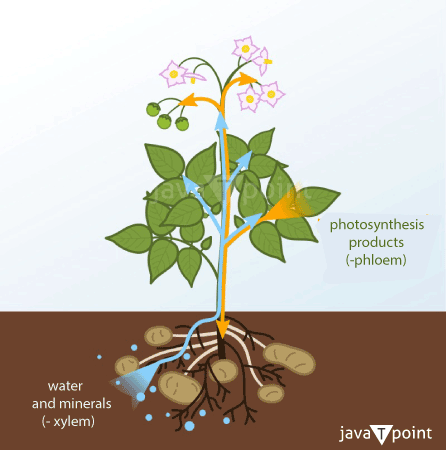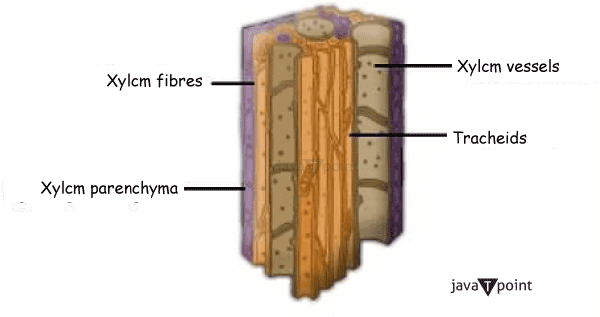Why is Xylem called the Dead Tissue?What is Xylem?The xylem is one of two major vascular tissues of plants, together with the phloem. These two tissues collaborate to move fluids throughout the plant. The xylem is in charge of transporting water, dissolved minerals, and other nutrients from the roots to the rest of the plant. The term "xylem" is derived from the Greek word "xylon," which means "wood," emphasising the tissue's critical role in the growth of woody stems and in providing structural support to the plant. 
The various specialised cell types that make up xylem each contribute to its distinct functions. Tracheids and vessel components are the two primary cell types in xylem, and both of these are inactive at maturity. Long, tapered cells called tracheids have thick walls with small pores that allow water to pass through. In contrast, vessel elements are longer, larger cells with perforations in their end walls that form continuous tubes known as vessels for better water conduction. Lignin, a complicated substance that gives the xylem tissue strength and stiffness, holds these cells together. Lignin also stops water from causing the vessels to collapse while rising. Xylem cells can create lengthy, unbroken channels because they are non-living and lack cytoplasm. Types of Cells in XylemThe main cell types found in xylem are tracheids, vessel elements, fibers, and parenchyma cells. 
Functions of Xylem
Types of XylemThe two types of xylem, primary and secondary, perform the same function but are categorized by the type of growth that they are formed with. 1. Primary Xylem The primary xylem develops as a plant grows. This is the expansion of stem tips, roots, and flower buds. It enables the plant to grow taller and longer roots. Primary growth happens early in the growing season, before secondary growth. Water and nutrients are carried by both primary and secondary xylem. 2. Secondary Xylem Secondary xylem is created during secondary growth in plants; this is the type of growth that permits the plant to grow broader over time. Wide tree trunks, for example, exhibit a great deal of secondary development. It happens every year after the main growth. The secondary xylem is responsible for the black rings on the inside of tree trunks, which are used for determining the age of the tree. Why is Xylem Referred to as "Dead Tissue"Xylem is known as "dead tissue" because of its morphological qualities. The primary water-conducting cells of the xylem, known as tracheids and vessel elements, lack protoplasts, which are the live components found in most plant cells. During the maturation phase, these cells experience apoptosis, a type of regulated cell death in which the protoplast disintegrates and leaves behind an empty channel. This structural modification in the tracheids and vessel elements serves specific functional purposes:
While the major water-conducting cells in the xylem do not have protoplasts and are therefore deemed "dead," it is crucial to highlight that the xylem is not completely non-functional or lifeless. Living cells and tissues surrounding the xylem, such as parenchyma cells and companion cells, serve critical functions in controlling water and nutrient flow. Furthermore, the term "dead tissue" does not indicate that the xylem is useless; on the contrary, it is critical to plant survival and growth by allowing the passage of water and nutrients from the roots to the rest of the plant. How is Xylem Different from Phloem?Phloem and xylem both contribute to the plant's system of circulation and combine to generate the vascular bundles that give the plant its mechanical strength, but they also differ significantly from one another. Phloem delivers food and nutrients, whereas xylem transports water. The function of the unidirectional xylem is to ensure that water flows upward. Phloem, on the other hand, is bidirectional and moves food and nutrients throughout the entire plant. While the phloem contains living cells, the mature xylem is composed of dead cells without cell contents. Both the xylem and phloem have different structures. Phloem is made up of sieve tubes with many pores for transferring nutrients, whereas xylem is made up of tracheid and vessels. Phloem is spherical and phloem is star-shaped. Significance of Xylem in PlantsIn order for plants to survive and flourish in a variety of conditions, the water balance within them must be maintained. This is where the xylem comes into effect. It makes sure that nutrients and water are efficiently dispersed throughout the entire plant, even in areas that are not close to the roots. Photosynthesis, the process by which plants make their own food by combining water, carbon dioxide, and light, depends on this constant supply of water. Additionally, xylem helps plants maintain their structural integrity, particularly those with woody stems. Lignin deposition in xylem cell walls offers mechanical support, enabling the plant to create a strong framework and grow tall. This support is necessary for the plant to withstand outside pressures like gravity and wind.
Next TopicLayers of Brain
|
 For Videos Join Our Youtube Channel: Join Now
For Videos Join Our Youtube Channel: Join Now
Feedback
- Send your Feedback to [email protected]
Help Others, Please Share









